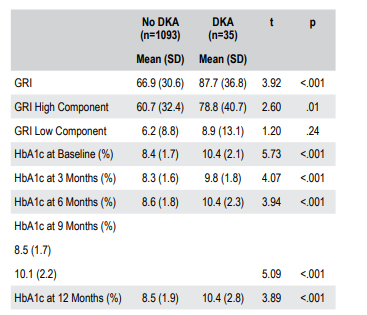Abstract: The Glycemia Risk Index Correlates with Hemoglobin A1C in Youth with Type 1 Diabetes and Is Elevated in Individuals Who Experienced Diabetic Ketoacidosis
K. Panfil1, C.A. Vandervelden1, B. Lockee1, E.M. Tallon1, D.D. Williams1, S.R. Patton2, C. Schweisberger1, R.Y. Sonabend3,4, D.C. Klonoff5, M.A. Clements1
1Children’s Mercy, Kansas City, United States, 2Nemour’s Children’s Health, Jacksonville, United States, 3Texas Children’s Hospital, Houston, United States, 4Baylor College of Medicine, Houston, United States, 5Mills-Peninsula Medical Center, San Mateo, United States
Introduction: The Glycemia Risk Index (GRI), which condenses the Ambulatory Glucose Profile into a single metric, was developed to describe the quality of glycemic control in adults with Type 1 diabetes (T1D). Whether GRI describes glycemia quality in youth with T1D remains unknown.
Objectives: We examined the relationship between GRI and hemoglobin A1c (HbA1c) in youth with T1D and compared GRI in youth who did and did not experience diabetic ketoacidosis (DKA) over 12 months.
Methods: In a retrospective design, we selected individuals who received care from a Midwest (USA) tertiary care pediatric diabetes clinic network, had >50% continuous glucose monitor (CGM) wear time, and T1D diagnosis occurred >1 year prior to sampling. We correlated a single GRI value calculated from 1 week of CGM data with HbA1c measurements collected at baseline (within 3 weeks of GRI calculation), 3, 6, 9, and 12 months later. Two sample t-tests were used to compare GRI and HbA1c values between individuals who did and did not experience a DKA event during the 12-month window.
Results: The cohort (N=764) included youth with T1D aged 2.5-21.1 years, with 49.4% males, 84.6% non-Hispanic White, 71.0% on commercial insurance, and a mean age of 13.1 years (SD=3.8). GRI positively correlated with HbA1c at baseline (r=0.7), 3 (r=0.6), 6 (r=0.6), 9 (r=0.6), and 12 (r=0.5) months. Individuals who experienced a DKA event had significantly higher GRI scores and HbA1c values at baseline, 3, 6, 9, and 12 months compared to individuals who did not experience DKA. The high component of the GRI score differed between groups but the low component did not.

Conclusions: GRI positively correlated with HbA1c over 12 months. GRI and HbA1c values were higher in youth who experienced DKA compared to those who did not. GRI may serve as an easily obtainable indicator of risk for DKA in youth with T1D.
Link: https://www.react-profile.org/upload/KIT/system/uploads/ISPAD2023_Abstracts.pdf